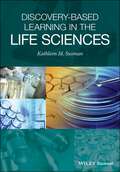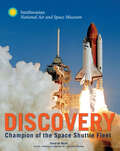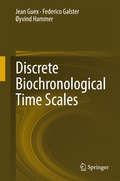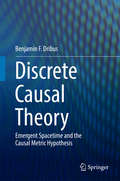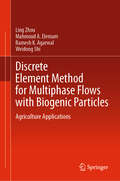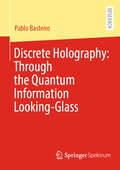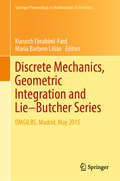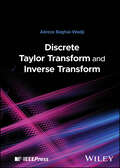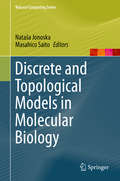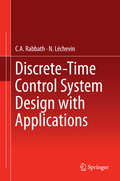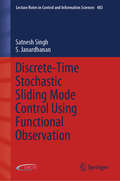- Table View
- List View
Discovery-Based Learning in the Life Sciences
by Kathleen M. SusmanFor nearly a decade, scientists, educators and policy makers have issued a call to college biology professors to transform undergraduate life sciences education. As a gateway science for many undergraduate students, biology courses are crucial to addressing many of the challenges we face, such as climate change, sustainable food supply and fresh water and emerging public health issues. While canned laboratories and cook-book approaches to college science education do teach students to operate equipment, make accurate measurements and work well with numbers, they do not teach students how to take a scientific approach to an area of interest about the natural world. Science is more than just techniques, measurements and facts; science is critical thinking and interpretation, which are essential to scientific research. Discovery-Based Learning in the Life Sciences presents a different way of organizing and developing biology teaching laboratories, to promote both deep learning and understanding of core concepts, while still teaching the creative process of science. In eight chapters, the text guides undergraduate instructors in creating their own discovery-based experiments. The first chapter introduces the text, delving into the necessity of science education reform. The chapters that follow address pedagogical goals and desired outcomes, incorporating discovery-based laboratory experiences, realistic constraints on such lab experiments, model scenarios, and alternate ways to enhance student understanding. The book concludes with a reflection on four imperatives in life science research-- climate, food, energy and health-- and how we can use these laboratory experiments to address them. Discovery-Based Learning in the Life Sciences is an invaluable guide for undergraduate instructors in the life sciences aiming to revamp their curriculum, inspire their students and prepare them for careers as educated global citizens. imperatives.
Discovery: Champion of the Space Shuttle Fleet
by Valerie NealThis book places Space Shuttle Discovery within the history of the space shuttle program and provides an introduction to space shuttle technology, with a focus on the orbiter itself. Discovery's unique history is presented mission by mission that includes a brief narrative of each mission, a chart of its key statistics (dates, duration, altitude, payloads, etc.), each mission's patch with an explanation of its unique symbolism, a crew portrait, and two to four iconic photos that capture the distinct activities and successes of each mission. The book also features anecdotes and memories of several astronauts who flew on Discovery, as well as its modernization over the years and its final preparation for retirement at the Smithsonian.
Discrete Biochronological Time Scales
by Jean Guex Federico Galster Øyvind HammerThe object of this book is to explain how to create a synthesis of complex biostratigraphic data, and how to extract from such a synthesis a relative time scale based exclusively on the fossil content of sedimentary rocks. Such a time scale can be used to attribute relative ages to isolated fossil-bearing samples. The book is composed of 10 chapters together with several appendices. It is a totally revised version of "Biochronological Correlations" published in 1991 and includes various new chapters. The book offers a solution for the theoretical problem of how fossils can be used to make reliable quantitative stratigraphic correlations in sedimentary geology. It also describes the use of highly efficient software along with several examples. The authors compare their theoretical model with 2 other relevant studies: probabilistic stratigraphy and constrained optimization (CONOP).
Discrete Causal Theory
by Benjamin F. DribusThis book evaluates and suggests potentially critical improvements to causal set theory, one of the best-motivated approaches to the outstanding problems of fundamental physics. Spacetime structure is of central importance to physics beyond general relativity and the standard model. The causal metric hypothesis treats causal relations as the basis of this structure. The book develops the consequences of this hypothesis under the assumption of a fundamental scale, with smooth spacetime geometry viewed as emergent. This approach resembles causal set theory, but differs in important ways; for example, the relative viewpoint, emphasizing relations between pairs of events, and relationships between pairs of histories, is central. The book culminates in a dynamical law for quantum spacetime, derived via generalized path summation.
Discrete Control Systems
by Yoshifumi OkuyamaDiscrete Control Systems establishes a basis for the analysis and design of discretized/quantized control systems for continuous physical systems. Beginning with the necessary mathematical foundations and system-model descriptions, the text moves on to derive a robust stability condition. To keep a practical perspective on the uncertain physical systems considered, most of the methods treated are carried out in the frequency domain. As part of the design procedure, modified Nyquist-Hall and Nichols diagrams are presented and discretized proportional-integral-derivative control schemes are reconsidered. Schemes for model-reference feedback and discrete-type observers are proposed. Although single-loop feedback systems form the core of the text, some consideration is given to multiple loops and nonlinearities. The robust control performance and stability of interval systems (with multiple uncertainties) are outlined. Finally, the monograph describes the relationship between feedback-control and discrete event systems. The nonlinear phenomena associated with practically important event-driven systems are elucidated. The dynamics and stability of finite-state and discrete-event systems are defined. Academic researchers interested in the uses of discrete modelling and control of continuous systems will find Discrete Control Systems instructive. The inclusion of end-of-chapter problems also makes the book suitable for use in self study either by professional control engineers or graduate students supplementing a more formal regimen of learning.
Discrete Element Method for Multiphase Flows with Biogenic Particles: Agriculture Applications
by Ling Zhou Ramesh K. Agarwal Weidong Shi Mahmoud A. ElemamThis book presents the advanced theory and application of the combined Computational Fluid Dynamics – Discrete Element Method (CFD-DEM) to multiphase flow simulations of the gas and bio-particulate matter of non-uniformly shaped biomass. It explores how DEM can simulate the complex behaviour of biomass particles, such as their packing in the multiphase flows that occurs in the agricultural product processing industries. It offers an overview of aerodynamic systems, such as cyclone separators, used in the agricultural processing industry. A detailed description of DEM modeling, including the particle-particle, particle-boundary, and particle-fluid interactions in the context of biomass particles of varying sizes and shapes, is provided. Coverage includes the critical application of CFD-DEM simulation technology in designing and optimizing grain handling and processing equipment and the application of extended DEM to other granular flows of complex particles like sand, powders, and dust from mines where clumping and agglomeration occur. The application of DEM in modeling and simulation of complex multiphase systems can help improve productivity, reduce costs, and increase efficiency in the agricultural industry.
Discrete Event Systems
by Moamar Sayed-MouchawehDiscrete Event Systems: Diagnosis and Diagnosability addresses the problem of fault diagnosis of Discrete Event Systems (DESs). This book provides the basic techniques and approaches necessary for the design of an efficient fault diagnosis system for a wide range of modern engineering applications. This book classifies the different techniques and approaches according to several criteria such as: modeling tools (Automata, Petri nets, Templates) that is used to construct the model; the information (qualitative based on events occurrences and/or states outputs, quantitative based on signal processing, data analysis) that is needed to analyze and achieve the diagnosis; the decision structure (centralized, decentralized) that is required to achieve the diagnosis; as well as the complexity (polynomial, exponential) of the algorithm that is used to determine the set of faults that the proposed approach is able to diagnose as well as the delay time required for this diagnosis. The goal of this classification is to select the efficient method to achieve the fault diagnosis according to the application constraints. This book will include illustrated examples of the presented methods and techniques as well as a discussion on the application of these methods on several real-world problems.
Discrete Fracture Network Modeling of Hydraulic Stimulation
by Roland N. Horne Mark W. McclureDiscrete Fracture Network Modeling of Hydraulic Stimulation describes the development and testing of a model that couples fluid-flow, deformation, friction weakening, and permeability evolution in large, complex two-dimensional discrete fracture networks. The model can be used to explore the behavior of hydraulic stimulation in settings where matrix permeability is low and preexisting fractures play an important role, such as Enhanced Geothermal Systems and gas shale. Used also to describe pure shear stimulation, mixed-mechanism stimulation, or pure opening-mode stimulation. A variety of novel techniques to ensure efficiency and realistic model behavior are implemented, and tested. The simulation methodology can also be used as an efficient method for directly solving quasistatic fracture contact problems. Results show how stresses induced by fracture deformation during stimulation directly impact the mechanism of propagation and the resulting fracture network.
Discrete Holography: Through the Quantum Information Looking-Glass
by Pablo BasteiroHow can we reconcile general relativity with quantum mechanics? One promising approach is the holographic principle, which posits that quantum gravity can be described by a lower-dimensional theory without gravity. This book advances the field of discrete holography by building models on discretizations of hyperbolic space, extending the AdS/CFT correspondence and enabling experimental tests of holographic predictions. The first part develops discrete bulk models on hyperbolic tilings, exploring scalar field instability and correlation functions, and proposes electric circuits as experimental platforms. The second part constructs boundary theories as disordered spin chains and analyzes their entanglement via tensor networks. The final part investigates quantum information measures—circuit complexity, geometric quantum discord, and operator algebras—to probe black hole properties in holographic dualities. This work uncovers new insights into holography and bridges theoretical concepts with experimental realizations.
Discrete Mathematics: for New Technology
by John Taylor Rowan GarnierIn a comprehensive yet easy-to-follow manner, Discrete Mathematics for New Technology follows the progression from the basic mathematical concepts covered by the GCSE in the UK and by high-school algebra in the USA to the more sophisticated mathematical concepts examined in the latter stages of the book. The book punctuates the rigorous treatment of theory with frequent uses of pertinent examples and exercises, enabling readers to achieve a feel for the subject at hand. The exercise hints and solutions are provided at the end of the book. Topics covered include logic and the nature of mathematical proof, set theory, relations and functions, matrices and systems of linear equations, algebraic structures, Boolean algebras, and a thorough treatise on graph theory. Although aimed primarily at computer science students, the structured development of the mathematics enables this text to be used by undergraduate mathematicians, scientists, and others who require an understanding of discrete mathematics.
Discrete Mechanics
by Jean-Paul CaltagironeThis book presents the fundamental principles of mechanics to re-establish the equations of Discrete Mechanics. It introduces physics and thermodynamics associated to the physical modeling. The development and the complementarity of sciences lead to review today the old concepts that were the basis for the development of continuum mechanics. The differential geometry is used to review the conservation laws of mechanics. For instance, this formalism requires a different location of vector and scalar quantities in space. The equations of Discrete Mechanics form a system of equations where the Helmholtz-Hodge decomposition plays an important role.
Discrete Mechanics, Geometric Integration and Lie–Butcher Series: Dmgilbs, Madrid, May 2015 (Springer Proceedings in Mathematics & Statistics #267)
by Kurusch Ebrahimi-Fard María Barbero LiñánThis volume resulted from presentations given at the international “Brainstorming Workshop on New Developments in Discrete Mechanics, Geometric Integration and Lie–Butcher Series”, that took place at the Instituto de Ciencias Matemáticas (ICMAT) in Madrid, Spain. It combines overview and research articles on recent and ongoing developments, as well as new research directions. Why geometric numerical integration? In their article of the same title Arieh Iserles and Reinout Quispel, two renowned experts in numerical analysis of differential equations, provide a compelling answer to this question. After this introductory chapter a collection of high-quality research articles aim at exploring recent and ongoing developments, as well as new research directions in the areas of geometric integration methods for differential equations, nonlinear systems interconnections, and discrete mechanics. One of the highlights is the unfolding of modern algebraic and combinatorial structures common to those topics, which give rise to fruitful interactions between theoretical as well as applied and computational perspectives. The volume is aimed at researchers and graduate students interested in theoretical and computational problems in geometric integration theory, nonlinear control theory, and discrete mechanics.
Discrete Taylor Transform and Inverse Transform
by Alireza Baghai-WadjiRevolutionize the calculation of mixed derivatives with this groundbreaking text Transform and inverse transform techniques, such as the Fourier transform and the Laplace transform, enable scientists and engineers to conduct research and design in transformed domains where the work is simpler, after which the results can be converted back into the real domain where they can be applied or actualized. This latter stage in the process, the inverse transform, ordinarily poses significant challenges. New transform/inverse transform techniques carry extraordinary potential to produce revolutionary new science and engineering solutions. Discrete Taylor Transform and Inverse Transform presents the groundbreaking discovery of a new transform technique. Placing a novel emphasis on the “position variable” and “derivative operator” as main actors, the Discrete Taylor Transform and Inverse Transform (D-TTIT) will facilitate the calculation of mixed derivatives of multivariate functions to any desired order. The result promises to create new applications not only in its allied fields of quantum physics and quantum engineering, but potentially much more widely. Readers will also find: Discussion of possible applications in electrical engineering, acoustics, photonics, and many more Analysis of functions depending on one, two, or three independent variables Tools for theoreticians and practitioners to design their own algorithms for solving specific boundary-value problems Discrete Taylor Transform and Inverse Transform is ideal for any scientific or engineering professional looking to understand a cutting-edge research and design tool.
Discrete Weak KAM Theory: An Introduction through Examples and its Applications to Twist Maps (Lecture Notes in Mathematics #2377)
by Maxime ZavidoviqueThe aim of this book is to present a self-contained account of discrete weak KAM theory. Putting aside its intrinsic elegance, this theory also provides a toy model for classical weak KAM theory, where many technical difficulties disappear, but where the central ideas and results persist. It therefore serves as a good introduction to (continuous) weak KAM theory. The first three chapters give a general exposition of the general abstract theory, concluding with a discussion of the relations between the results proved in the discrete setting and the analogous theorems of classical weak KAM theory. Several examples are studied and some key differences between the discrete and classical theory are highlighted. The final chapter is devoted to the historical problem of conservative twist maps of the annulus.
Discrete and Continuum Models for Complex Metamaterials
by David J. Steigmann Francesco Dell’isolaBringing together contributions on a diverse range of topics, this text explores the relationship between discrete and continuum mechanics as a tool to model new and complex metamaterials. Providing a comprehensive bibliography and historical review of the field, it covers mechanical, acoustic and pantographic metamaterials, discusses Naive Model Theory and Lagrangian discrete models, and their applications, and presents methods for pantographic structures and variational methods for multidisciplinary modeling and computation. The relationship between discrete and continuous models is discussed from both mathematical and engineering viewpoints, making the text ideal for those interested in the foundation of mechanics and computational applications, and innovative viewpoints on the use of discrete systems to model metamaterials are presented for those who want to go deeper into the field. An ideal text for graduate students and researchers interested in continuum approaches to the study of modern materials, in mechanical engineering, civil engineering, applied mathematics, physics, and materials science.
Discrete and Topological Models in Molecular Biology
by Nataša Jonoska Masahico SaitoTheoretical tools and insights from discrete mathematics, theoretical computer science, and topology now play essential roles in our understanding of vital biomolecular processes. The related methods are now employed in various fields of mathematical biology as instruments to "zoom in" on processes at a molecular level. This book contains expository chapters on how contemporary models from discrete mathematics - in domains such as algebra, combinatorics, and graph and knot theories - can provide perspective on biomolecular problems ranging from data analysis, molecular and gene arrangements and structures, and knotted DNA embeddings via spatial graph models to the dynamics and kinetics of molecular interactions. The contributing authors are among the leading scientists in this field and the book is a reference for researchers in mathematics and theoretical computer science who are engaged with modeling molecular and biological phenomena using discrete methods. It may also serve as a guide and supplement for graduate courses in mathematical biology or bioinformatics, introducing nontraditional aspects of mathematical biology.
Discrete-Time Control System Design with Applications
by C. A. Rabbath N. LéchevinThis unique book provides a bridge between digital control theory and vehicle guidance and control practice. It presents practical techniques of digital redesign and direct discrete-time design suitable for a real-time implementation of controllers and guidance laws at multiple rates and with and computational techniques. The theory of digital control is given as theorems, lemmas, and propositions. The design of the digital guidance and control systems is illustrated by means of step-by-step procedures, algorithms, and case studies. The systems proposed are applied to realistic models of unmanned systems and missiles, and digital implementation.
Discrete-Time Sliding Mode Protocols for Discrete Multi-Agent System (Studies in Systems, Decision and Control #303)
by Axaykumar Mehta Keyurkumar PatelThis book presents few novel Discrete-time Sliding Mode (DSM) protocols for leader-following consensus of Discrete Multi-Agent Systems (DMASs). The protocols intend to achieve the consensus in finite time steps and also tackle the corresponding uncertainties. Based on the communication graph topology of multi-agent systems, the protocols are divided into two groups, namely (i) Fixed graph topology and (ii) Switching graph topology. The coverage begins with the design of Discrete-time Sliding Mode (DSM) protocols using Gao’s reaching law and power rate reaching law for the synchronization of linear DMASs by using the exchange of information between the agents and the leader to achieve a common goal. Then, in a subsequent chapter, analysis for no. of fixed-time steps required for the leader-following consensus is presented. The book also includes chapters on the design of Discrete-time Higher-order Sliding Mode (DHSM) protocols, Event-triggered DSM protocols for the leader-following consensus of DMASs. A chapter is also included on the design of DHSM protocols for leader-following consensus of heterogeneous DMASs.Special emphasis is given to the practical implementation of each proposed DSM protocol for achieving leader-following consensus of helicopter systems, flexible joint robotic arms, and rigid joint robotic arms. This book offers a ready reference guide for graduate students and researchers working in the areas of control, automation, and communication engineering, and in particular the cooperative control of multi-agent systems. It will also benefit professional engineers working to design and implement robust controllers for power systems, autonomous vehicles, military surveillance, smartgrids/microgrids, vehicle traffic management, robotic teams, and aerial robots.
Discrete-Time Stochastic Sliding Mode Control Using Functional Observation (Lecture Notes in Control and Information Sciences #483)
by Satnesh Singh S. JanardhananThis book extrapolates many of the concepts that are well defined for discrete-time deterministic sliding-mode control for use with discrete-time stochastic systems. It details sliding-function designs for various categories of linear time-invariant systems and its application for control. The resulting sliding-mode control addresses robustness issues and the functional-observer approach reduces the observer order substantially. Sliding-mode control (SMC) is designed for discrete-time stochastic systems, extended so that states lie within a specified band, and able to deal with incomplete information. Functional-observer-based SMC is designed for various clauses of stochastic systems: discrete-time; discrete-time with delay; state time-delayed; and those with parametric uncertainty. Stability considerations arising because of parametric uncertainty are taken into account and, where necessary, the effects of unmatched uncertainties mitigated. A simulation example is used to explain the use of the functional-observer approach to SMC design. Discrete-Time Stochastic Sliding-Mode Control Using Functional Observation will interest all researchers working in sliding-mode control and will be of particular assistance to graduate students in understanding the changes in design philosophy that arise when changing from continuous- to discrete-time systems. It helps to pave the way for further progress in applications of discrete-time SMC.
Discrete-Time and Discrete-Space Dynamical Systems (Communications and Control Engineering)
by Lihua Xie Lijun Zhang Kuize ZhangDiscrete-Time and Discrete-Space Dynamical Systems provides a systematic characterization of the similarities and differences of several types of discrete-time and discrete-space dynamical systems, including:Boolean control networks;nondeterministic finite-transition systems;finite automata;labelled Petri nets; andcellular automata.The book's perspective is primarily based on topological properties though it also employs semitensor-product and graph-theoretic methods where appropriate. It presents a series of fundamental results: invertibility, observability, detectability, reversiblity, etc., with applications to systems biology.Academic researchers with backgrounds in applied mathematics, engineering or computer science and practising engineers working with discrete-time and discrete-space systems will find this book a helpful source of new understanding for this increasingly important class of systems. The basic results to be found within are of fundamental importance for further study of related problems such as automated synthesis and safety control in cyber-physical systems using formal methods.
Discretization and Implicit Mapping Dynamics
by Albert C. J. LuoThis unique book presents the discretization of continuous systems and implicit mapping dynamics of periodic motions to chaos in continuous nonlinear systems. The stability and bifurcation theory of fixed points in discrete nonlinear dynamical systems is reviewed, and the explicit and implicit maps of continuous dynamical systems are developed through the single-step and multi-step discretizations. The implicit dynamics of period-m solutions in discrete nonlinear systems are discussed. The book also offers a generalized approach to finding analytical and numerical solutions of stable and unstable periodic flows to chaos in nonlinear systems with/without time-delay. The bifurcation trees of periodic motions to chaos in the Duffing oscillator are shown as a sample problem, while the discrete Fourier series of periodic motions and chaos are also presented. The book offers a valuable resource for university students, professors, researchers and engineers in the fields of applied mathematics, physics, mechanics, control systems, and engineering.
Discrimination and Access to Justice in Africa: Language, Vulnerability and Social Inclusion in Southern and Eastern Africa (Law, Language and Communication)
by Wellman Kondowe Paul SvongoroThere are different forms of discrimination. Among others, people can be discriminated against on the basis of their ethnic grouping, political affiliation, race, gender, age, and language. This book focuses on linguistic discrimination in Africa, acknowledging that language plays a key role in the delivery of justice and much of what transpires in justice systems deals with language use. It argues that to achieve fairness, the state has a responsibility to put in place accommodations aimed at reducing linguistic vulnerability. The collection interrogates some of the issues that are common in Africa, which is arguably one of the most linguistically diverse continents in the world, bringing together a collection of case studies from Malawi, South Africa, Zimbabwe, Tanzania, Kenya, and Zambia. It presents practical insights from academics, legal professionals, and social scientists. Divided into five thematic parts, the first addresses communication and linguistic challenges faced by children in the legal system. Theme 2 examines the position of witnesses with physical challenges. The third theme focuses on language as a barrier in access to justice. Theme 4 looks at the language of the court as a major barrier to the poor and the illiterate. The fifth and final theme examines the position of women in sexual assault cases. The collection will be of interest to academics, researchers, and policymakers working in the areas of law and language, human rights law, criminology, linguistics, and African Studies.
Discrimination of Mobile Supramolecular Chirality: Acylative Molecular Transformations by Organocatalysis (Springer Theses)
by Ayumi ImayoshiThis book proposes a novel concept for molecular recognition. In the field of asymmetric synthesis approaching the mature science, asymmetric discrimination and catalytic synthesis of chiral supramolecules still stand as unsolved problems. The extreme difficulty in asymmetric synthesis of such supramolecules may result from the mobile nature of supramolecular chirality. Here the author shows the first highly enantioselective synthesis of mechanically chiral supramolecules. In the presence of a chiral organocatalyst, a mechanically planar chiral rotaxane was obtained with p erfect enantiopurity (>99% ee) with an excellent selectivity. The dynamic and flexible recognition mode enabled asymmetric synthesis of supramolecules with conformational flexibility and mobility. The recognition mode of the catalyst is a contrast to the traditional static and rigid recognition mode of the typical conventional catalysts. The concept of dynamic molecular recognition will be adopted as a novel concept in a wide range of fields beyond the field of organic chemistry, including material chemistry, biochemistry, and medicinal chemistry.
Discriminative Learning in Biometrics
by David Zhang Yong Xu Wangmeng ZuoThis monograph describes the latest advances in discriminative learning methods for biometric recognition. Specifically, it focuses on three representative categories of methods: sparse representation-based classification, metric learning, and discriminative feature representation, together with their applications in palmprint authentication, face recognition and multi-biometrics. The ideas, algorithms, experimental evaluation and underlying rationales are also provided for a better understanding of these methods. Lastly, it discusses several promising research directions in the field of discriminative biometric recognition.
Disease Causing Microbes
by Jaishree PaulThis book provides knowledge on the diversity of disease-causing microbes including bacteria, viruses, fungi and protozoans—the major diseases they cause and the environmental factors that influence the occurrence, transmission and spread of microbes along with the epidemiological factors determining the occurrence of disease. The book mainly covers a broad spectrum of diseases infecting different organs of human and describes the microorganisms involved in the process. The diseases caused by parasites and helminths are also included in the text since the infective stages of parasites as well as helminths are microscopic in nature and need to be distinguished from bacterial infections by appropriate diagnosis.
